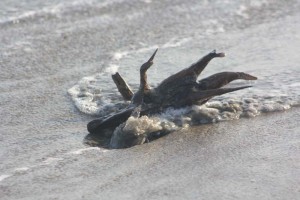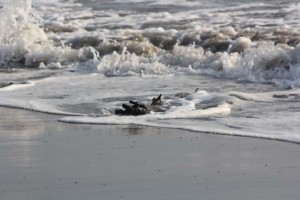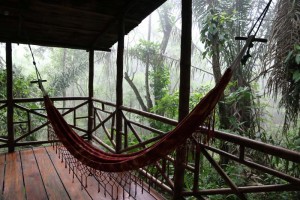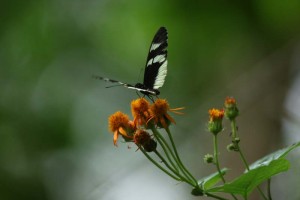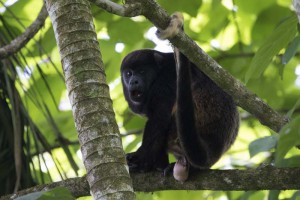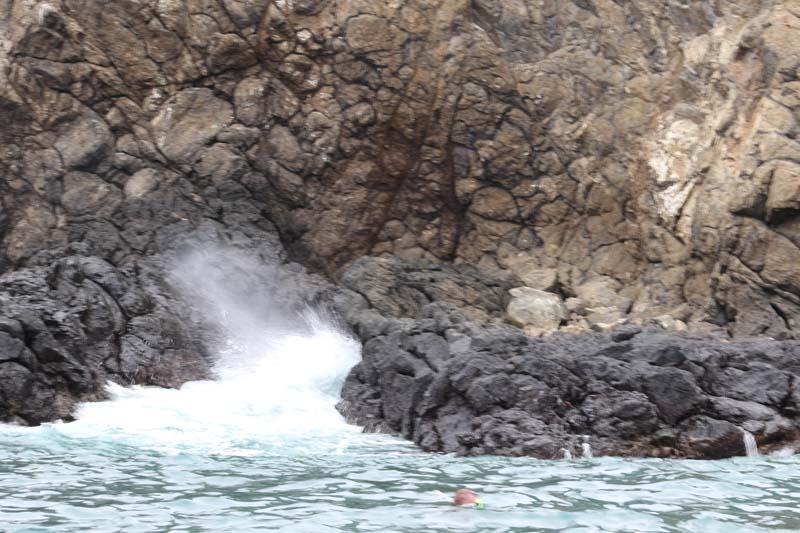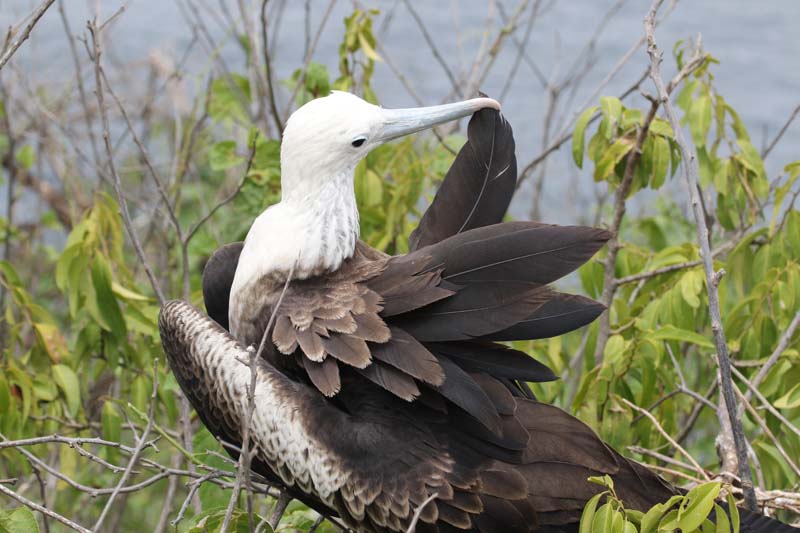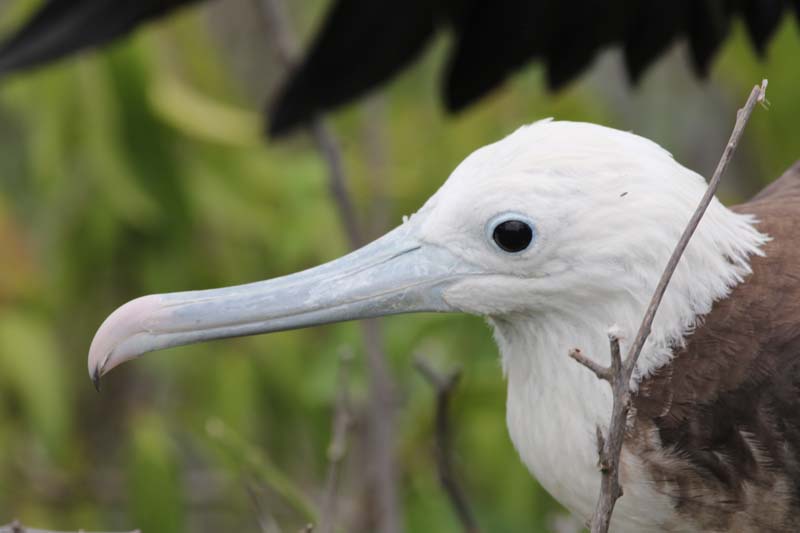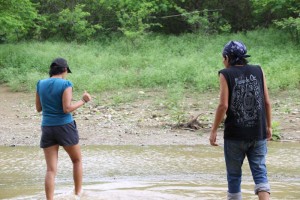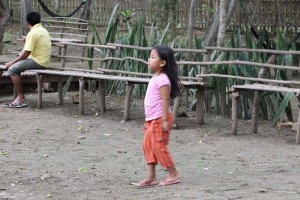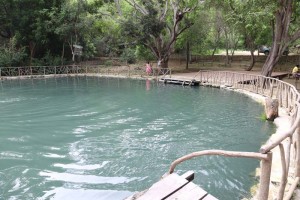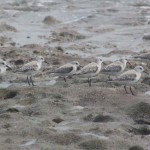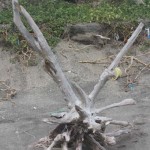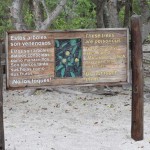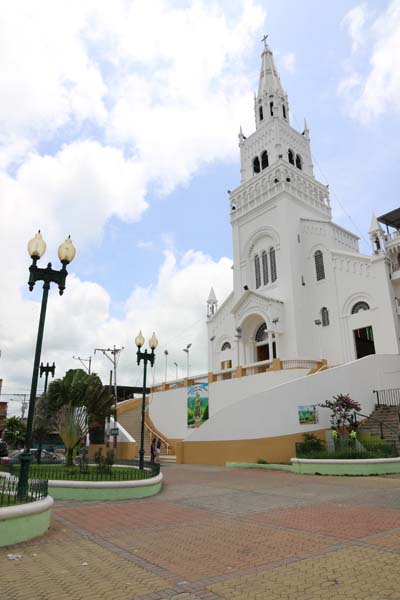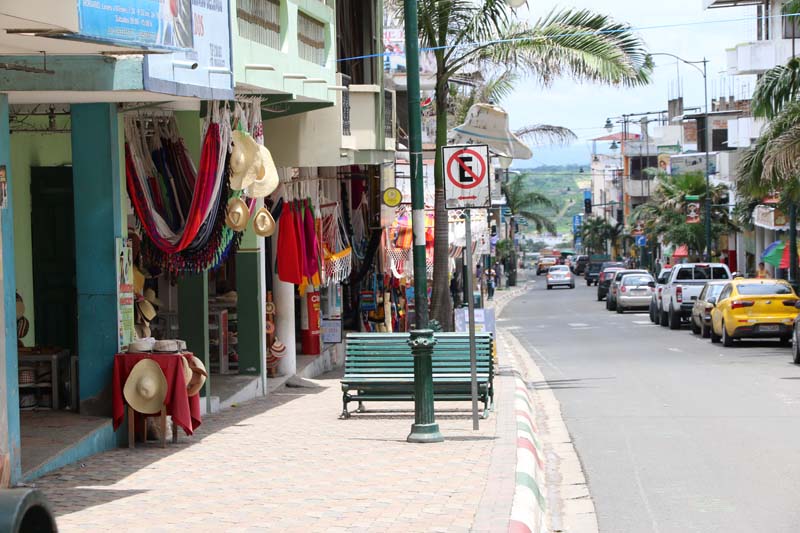Surf and Turf
I know it sounds like an odd topic but walking the beaches on almost a daily basis, I see what the high and low tides do to the beaches. I think some of the high tides are higher and different, by how far we can walk down the beach. Remember the picture I or Leo posted about the family having a special dinner on the rocks; at the last high tides we could not even see the rocks or could not even go past the cliffs. The next time we walked the beach after the very high tide the amount of garbage left on the beach was incredible, although I found a lot of it looked like sculptures and works of art. I tried to pull some of the drift wood out of the sand but could not budge it. Leo and I think it was buried about 2 feet down because of the tides going in and out and burying it deeper and deeper. Check out some of my pictures.
Pacoche Lodge and Reserve
You know how when you have had a few experiences in a place and they turned out to be slightly less than expected and you have a new experience to look forward to you most often will lower your expectations before you arrive at the next one.
This was the case before we left for Pacoche. Of course we had read all about it, seen the pictures and read the reviews but still we braced for an underestimation. It all turned out to be the total opposite.
From the moment we stepped off the bus and saw Ana standing by the side of the road, in the rain, waiting to greet us we knew the stay would be perfect. And it was. We walked up the path towards the lodge chatting away and Johnny, the valet, pointed out several howler monkeys sitting in trees along the path. We signed in, checked into our cabin and returned to the path where we had seen the monkeys. They had moved further into the forest. We could still hear them but there was no way to get to where they were.
The rain started to come down heavier but we were in a rain forest and it was sort of expected. We didn’t let a little rain stop us from exploring the jungle. In fact the rain felt kind of nice, the air was hot and humid and the drizzle had a bit of a cooling effect. The jungle was massive and surrounded us on all sides. The songs of the birds was magical. Most of the birds we could not see but the sounds were exactly what you would expect them to be. The path took us on a long loop up over a hill and down into a valley and back again. By the time we got back to the cabin our shoes had a solid 2 inches of mud on the soles. A change and a shower brought us to lunch.
Ana promised us that the food would be endemic to the area and it was. Like most coastal region dishes it would have a mound of rice, plantain, seafood of some sort and a small salad. This was basically what it was but the flavor was a notch up from any we had tasted so far. The rice was a smaller portion (which is a good thing), the fish was fresh tuna with a garlic sauce and grilled shrimp on top. The salad had a hint of cilantro and basil that we found out was grown in a little patch behind the kitchen. I think it was the first time we had seen fresh herbs being used. This was followed by a passion fruit mousse. And this was lunch!
In the afternoon Marianne was starting to really feel the effects of a head cold she had started the day before so I insisted she hang out in the hammock on our deck overlooking the jungle. I took my second hike into the jungle to explore a bit more. I took a couple of side ventures off the path to explore a palm plantation. The type of palm they use to make the Panama Hats. Later when I told Ana where I had been her only comment was that when you stray from the path you are more likely to encounter snakes. Great.
As we waited for supper we played scrabble on the porch of the lodge. Butterflies (mariposas) of every imaginable color combination flitted around from flower to flower. Birds sang and howler monkeys howled in the distance. We were the only guests at the lodge tonight so it seemed so special to see our table set at the window. We had the jungle, the wildlife, the lodge and the staff all to ourselves. Johnny brought our dinner so we moved inside. Once again rice, plantain and salad but with a beautifully spiced shrimp in a buttery sauce. Desert was a fresh baked round cake with homemade passion fruit ice cream.
It was such a treat to the soul to fall asleep to the sounds of the jungle also going to sleep and to wake with the same jungle sounds as they woke. At dawn I took a shorter hike to a spot where there was a bench next to a palm workers lean to and sat and listened. It was magical. I know I haven’t been that much at peace with myself in a long time. On the way back for breakfast saw some birds I could add to my lifers list if only I had one.
We had enough time for our fourth and final hike before we had to pack up and wait for our ride home. Marianne joined me this time and because she still wasn’t feeling all that well I promised to go slow and rest often. That we did. We got as far as the same bench, sat for a while and Marianne decided she wanted to attempt hiking through to the valley. As we started up the trail there is a crest to go over before you start downhill towards the valley. As we breached the crest there in the tree directly in front of us was a male howler monkey looking straight at us. We froze for a moment then started taking pictures. It turned out there were 7 in the family. The one male, four females and two juveniles. They posed and posed some more before deciding they were bored with the humans and moved on into the jungle. I could not have been more thrilled. I had travelled some 4000 miles with the hopes of seeing howler monkeys in the wild and was successful. Major item to cross off bucket list.
Back to the lodge for lunch. Ana had promised us a treat of Tonga, a local dish of rice, chicken and peanut steamed in a plantain leaf. It was a treat.
This was the first place during our stay that we felt reluctant to leave. It was a little paradise that was all ours for 2 days.
Check it out !
http://www.pacochelodge.org/index.php
MASTERING ECUADORIAN FOODS AND GOODS
Our first run in with buying Ecuadorian foods, was February 2nd at 7:30 pm after traveling for almost 2 days. We were told by our driver Jo Lynn that Super Maxi in Manta would be closing at 8:30, OK that gave us an hour. We had made up a very careful list of what we would need knowing that this grocery store is approximately 1 hour drive from Mirador San Jose. Jo Lynn thought it best that she stay with her car to watch our luggage. Into the store we go grocery cart and list in hand. It was a real learning experience in a lot of the aisles and we soon realized that any prepackaged goods ie sun screen, toothpaste, toilet paper is very expensive. We had no idea what was already in the house; in the cart toilet paper, paper towels, Kleenex (no we can use toilet paper), dish soap, laundry soap. We were already told ahead of time that all toilet paper goes into the garbage can non can go into the toilet because of the system they have in MSJ or you can use biodegradable toilet paper. SHEESH try and find biodegradable toilet paper was impossible we were limited to time, could not read a word of Spanish, exhausted and saw the two guards at the door with bullet proof vests, billy clubs and guns. We knew we had to get the shopping done and fast. Meat counter WOW, the prices unbelievable, T bone steaks 2 for $4.50, chicken 5 drumsticks $2.50, and pork chops 4 for $4.00 etc etc. What was expensive was bacon, weiners, and some deli cuts. Odd things milk (super pasteurized), eggs and margarine not in the coolers and yogourt sold in litre bags. With 10 minutes to spare we had a cart full and spent $141.00, loaded up the car and headed to our place of residence for the next two months.
Because I have IBS I am very careful what I eat and have limited ourselves to which restaurants we eat when we are out. But we have found that every Ecuadorian meal consists of soup, rice and deep fried plantain, all not too bad but very bland. Here at home we stick to things we like and I can eat. With the computer and Spanish dictionary close by we can figure out how to prepare, soups, rice etc.
Every Friday the veggie truck goes around MSJ honking his horn to back his presence known. We can fill our fridge with all the necessary fruits and vegetables that we need for a week without spending very much money (never over $10 a trip). The corner store sells any staples that you might require at a bit higher cost than at the Super Maxi. We usually end up getting eggs, milk, beer, chips etc.
We enjoy eating the eggs they are as good as or better than the farm eggs we buy in Almonte. Bacon is not like our bacon very lean and just a different taste. I am not a bread eater so I have very happy to find English muffins on our last visit to the Super Maxi, but again not like ours very doughy. Leo was itching to have pancakes so we purchased pancake mix and syrup for a breakfast, OH my it was a different experience.
A couple of weeks ago our driver friend Juan took us to as fishing village and we purchased 3 fairly large fish???? For $5.00. Barbequed them and they were delicious. Next time we will fillet them very hard to eat with all the bones. What is nice you can purchase freezer packed meat and fish at the corner store; we have purchased tuna, shrimp, hamburger and steak all at approximately $7.00 per pound.
The pub Ko Ko Mo serves Quebec style pub food ie poutine, fish and chips, some salads and sometimes specials. Prices are good, only the French people from MSJ hang out there so it gets very loud and no one talks to us poor English people. OH well each to their own. The owner is very friendly but does not speak a word of English.
That is it for my food and shopping experiences in Ecuador. But I am very glad I listened to my friend in Canada to
bring spices in small baggies with me, next time I will bring more variety and more of each kind. Thanks Fran.
Isle de la Plata
Isle de la Plata was my alternative. I would have loved to go all the way to the Galapagos and made it a proper adventure but the Canadian dollar and some of the people pollution issues I have read about made it beyond reach and beyond reality for us. I hate exploitation in any form and it seems that the human interference on Galapagos is now a struggle for the park commission to reverse. Galapagos is another one of those things I am 40 years to late in seeing. My advice to anyone is to grab opportunity when it arises and to not wait. For many many reasons I waited and those same opportunities may never come again.
Isle de la Plata is referred to as “the poor mans Galapagos” . I refer to it as another ecosystem on to it’s own. I was actually one of the two most anticipated excursions I planed on while I was here. The second one is still to happen.
Both of us were unjustifiably concerned about sea sickness and the intensity of the climb when we got there. Neither of us ot sea sick and we both, even tho it was tough at times completed our hikes. I was glad Marianne came to grips with her limitations and decided on a shorter easier loop than mine. I opted for the full hike which was a little over 5 km. May not seem like a long hike but when you are on the top plateau of the island and the temperature reached 45C with no shade it made it very challenging to the old guy as well as the younger ones that were with me. A third of the hike was uphill and the rest was along the cliff face.
I certainly was not disappointed. We saw 5 species of boobies, frigate birds, tropical red billed bird, mocking birds and pelicans. Our guide, Wellington, was thrilled when we came across some masked boobies. They apparently are quite rare and he asked for copies of pictures we took. We also saw blue footed, red, Nazca and the brown. The red and the brown were a far distance from the path so pictures are few or not at all.
There were still some chicks to be seen and they of course were entertaining. Few of the male frigates were in breeding shape and the ones that were also were far from the path.
Would have been nice to see some marine life but that did not happen for me. Marianne’s hike took her to the edge of the cliff where in the clear waters they were able to see tiger sharks and rays swimming in the bay. They got to the boat long before my group did and they had green sea turtles and colorful fishes around the boat feeding.
Some of the group went snorkeling. We opted out. I sink at the best of times and am not the best of swimmers. Marianne was nice to sit out with me. We enjoyed the breaking surf against the rocks instead.
Best day we have had while here, enjoyed every minute.
Some pictures in a gallery below.
Agua Blanca
As defined “Agua Blanca is a private community within Machalilla National Park hosting remains of one of the most ancient civilizations in South America, the Monteño, along with trails and a sulfur lagoon.”
We arrived at Agua Blanca from Los Frailes beach at lunch time. When asked in the morning if we preferred to have lunch back in Peurto Lopez or to share lunch with the community at AguaBlanca we ,of course, chose Agua Blanca.
Let me try to paint a picture. Stepping out of our car we are in the middle of an intersection of the two dirt roads that make up the village. Numerous people, children, cats, dogs, chickens and goats scoot in and out of the buildings and yards. Some faces turn towards and some don’t. To our left is a church with a covered porch and a dozen or so pews facing towards the road.
All the buildings have thatched roofs and any plastered surface is a dirty white. Straight ahead is the musuem. The only indication of what anything is are little tourist signs marking each building. The street meanders off to the right with several small houses.
A replica raft with a colorful sail marks the intersection to the right. Directly behind us is the restaurant. It too has a thatched roof, dirty white plaster and bamboo framing. We step down two steps from the road and through a gate that is wedged into the mud. Inside to the left is a room under the roof with a window and ledge. A man leans his chin onto his folded hands waiting for us to make first contact. Behind his room is a open door with a purple sheet hanging in the doorway and within is the kitchen. Our guide has a conversation with the man and reports what is available today. We choose and sit at one of the tables with the tablecloth nailed to the table top. The seating area is an open area with the bamboo frame showing under the thatched roof. Some areas of the roof were sagging more than others. Two hammocks hang from the posts behind us. Two stray dogs wander in and position themselves between us and watch. A woman brings out large glasses of a fruit smoothie like drink. Not sure what the fruit is, perhaps passion fruit. It is cold and tastes refreshing. Seeing ice cubes in the glass sparked a bit of fear but we comment that we are up to date with all our shots. The dogs get restless and lie down under the table. All I can picture is fleas hopping from dog to leg. Our meals arrive. A standard plate with a mound of rice, deep fried plantain, a small salad and a fillet of breaded chicken. Always good but by north American palette slightly bland. Dogs have perked up hoping for a morsel. In front of the restaurant a truck dives slowly by, laden with vegetables and fruit. A man hangs out the window with a megaphone pressed to his mouth. Speaking much faster than the truck is traveling he loudly announces his wares. As we eat we see a goat approaching on the road.
He does not hesitate at all but enters through the gate, looks about, glances at us then pushes the purple sheet aside and wanders through the kitchen. A few minutes later I see him on the hill right behind the restaurant. I guess it was a shortcut.
Two chicks and a mother hen are the next visitors as they come in and remove a few insects from the half wall that is between the road and the restaurant. We greet each of our visitors as they arrive with a smile. We finish or meal and gather our things to leave. The dogs also leave, disappointed.
The museum depicts the history of the peoples who live here and the reasons why they are still allowed to live in what is now a national park. It is small and seems to concentrate on the burial methods of their ancestors. Several urns in glass cubes have the remains of different classes of people. Our museum guide is will informed and apparently very knowledgeable about his history. He gives us the tour in Spanish and Aude, our guide, translates.
Leaving the museum our guides bring us through a jungle path stopping to show us excavation sites and points of interest. We cross a river twice.
Leather sandals are not the best for this kind of walk. Had to remove them to cross the water otherwise they would never have dried. Evenually we arrive at the sulfur lagoon and spa. You are given a cup of mud to rub on whatever part of your body you would like. You also have the option of having a masseuse massage your full body with the mud. We were told to let the mud dry and then to wade into the lagoon to wash it off. I have never smelt something so disgusting. The lagoon is over 70% sulfur. It burned the senses.
The walk back to the village was easier along the road. Marianne commented that they should have taken us that way to begin with.
Overall it was a good experience. To learn some of the history was important and haveing the village share some of their food with us was humbling. Everyone in the community has a role they play and they take care of one another. The food gatherers and farmers share the harvest with the ones who work within the town and the ones who take turns being guides. Whatever is left over is shared with visitors.
BEACH PHOTO WALK
BEACH PHOTO WALK
Went for our daily beach walk and out of the blue Leo says bring your camera, I am not bringing mine. OKIE DOKIE!!!!! The surf was wilder and higher than it has been in days, I am eyeing Isle de la Plata in the distance and thought OK I will try and catch the surf and the island. Shot about 10 frames and maybe I have been with Leo too long my attention span caught pieces of drift wood, piles of fisherman’s turquoise rope. Back to the surf and then pictures of Leo bobbing in the surf. All in all I think I took about 200 pictures, great time and we will see what the master photographer thinks of the outcome. At home Leo took his time going over every shot and was very impressed with what I took that day on the beach in beautiful Ecuador. Below are some of my shots see what you think…….By the way Leo is an excellent and patient teacher.
THREE DAYS, FOUR EXCURSIONS
We were picked up from MSJ on the first day at 8:30 am by our driver and host Aude. We found out that Aude is here with her boyfriend a diving instructor from France. Aude speaks fluent French, Spanish and English WOW, but especially needs the Spanish to be working for the huge tour company.
We drove about an hour to get to our hotel Hostera Oceanic where we are staying for 2 nights during the excursions just outside of the town Puerto Lopez. Google map of hotel and area
We unpacked and got ready for our first excursion Los Frailes Beach, our driver drove for about a half hour through a grove of trees that looked like an enchanted forest. Got to the beach had to sign in and listen to all the rules and regulations of the Parks of Ecuador. Asked for our passports, OOPS! Our host had not told us to bring them, I did my looking sad and smiling and the agent said we could go through. Drove on winding roads for about 5 km, parked brought water bottles and knap sack and camera equipment. Another tour guide stopped us inspected all of our gear inquired if we had food, cigarettes, etc (if you had any it had to be left behind with him to pick up later) and walked down to an amazing white beach with this indescribable surf. We walked from one end of the beach to the other, Leo took some amazing pictures. Los frailes beach
By the way I decided not take my big canon camera and was having problems with my tiny camera, every day we had some rain, extreme heat and humidity. I depended on Leo to take all of the pictures that is why I have added the web sites. I am in a way sorry that I had no camera because Leo does not like taking ie the village or people pictures because he feels he is invading in their privacy.
For lunch we went to our excursion at Aqua Blanca, it is a very small village made up of about 200 people that the government allowed to live there because of their historic background dating back to the Incas. We had lunch in a local restaurant, with the goats, chickens, dogs, and people in hanging hammocks SHEESH!!! We had a choice of fish and chicken, Leo and I choose chicken thinking since it was deep fried that might be the safest. Must say the lunch was delicious, also a little unnerving was the juice with the ice cubes. I could still hear the travel doctor saying “don’t drink anything with ice cubes”.
After lunch we visited the museum, did the long trek to the sulphur lagoon, we learned an awful lot of their culture and the people. Aqua blanca



First day is completed, back to the hotel to shower again to get the Sulphur smell off. It reminded us of the house in Corkery Woods that had Sulphur in the drinking water, within a week we had a water filtering system installed. We had a delicious seafood supper and ice cold beers at our hotel and collapsed in bed for a much needed rest to get ready for day two.
Day 2 – the most anticipated excursion – Isles de la Plata (‘poor man’s galapagos’ – we had researched both islands and decided there was no way we could afford the big Galapagos). We had also researched about sea sickness and read the best way not to get sick is to take one gravol (new chewable ginger non-drowsy) the night before and one in the morning and wear the motion sickness wrist bands. We were picked up at 8:30 and driven to Puerto Lopez where we were given instructions to walk to the peer where we would meet one of our tour guides. One of the couples who went with us are from Holland, as soon as they started speaking I understood the language, small world. Our boat arrived about a 27 foot with 2 – 150 hp motors, quite impressive looking. About 14 people are escorted on board, my heart is racing with anticipation. We are all asked to take off our socks and all foot wear (we all guessed not to make the boat dirty) and given life jackets. With a deafening noise of the engines we are off for an hour boat trip across the Pacific to Isles de la Plata. On the way one of the tour guides goes around with pieces of cake his Mother has made to give us energy when we reach the island. Three quarters of an hour we see glimpses of the majestic island. We arrived with the help of tour guides we jump into the water and walk to shore, we were are met with other guides. Bathroom and water breaks, retrieve our footwear and start our first hike to the top of the island. Absolutely grueling straight upward climb, I could almost not breathe. At the top we had a choice of which hike we wanted to continue on, Leo of course picked the most difficult and longest route and I stuck with the shortest and easiest hike. No point in fooling myself, there was no way I had the stamina to go on the long hike and I had also fallen two days before and still had the scrapes and bruises on my legs. Going to definitely work on getting more fit when we get home. The hike was absolutely exhilarating the blue and red footed boobies, lizards and views from the cliffs were amazing as you will see from Leo’s pictures. It was not the right time of the year to see whales but we did see a striped shark and a stingray. After about 3 hours our first group was back on boat waiting for the second group. We were given juice, sandwiches, fruit (pineapple and watermelon). After about a half hour the second group arrived, were fed and then you could go snorkeling. Because of my open scrapes and Leo not able to float and didn’t want to do it with a life jacket on we and about another 6 watched. We were very lucky to see three large turtles come right up to the side of the boat. The ride back to the mainland was a lot rougher than in the morning, arrived back on the mainland retrieved our runners and were driven back to the hotel. WOW what a day!!!


Day 3 – excursion #4 – The Rain Forest in Machililla National Park. We were picked up at the hotel at 8:30; it had rained again during the night and was very hot and humid. We were wearing long pants, socks, hiking boots and long sleeves which made it even hotter. None of the streets in Puerto Lopez are paved, it is incredible muddy, and you can really see the poverty in this area. Dogs and kids on bare feet running through the streets, big trucks roaring past everything on their way to fix other roads. An hour winding through the potholes and mud we arrive in a tiny village (Leo took a picture of the name) and our tour guide Wilmer, who with his parents have lived there all of their lives. Again I have a very hard time seeing past the broken down shacks and kids, dogs, cats, chickens running around everywhere.
Wilmer gave us each rubber boots, and rain ponchos for the trek through the rainforest. Our guide was very knowledgeable about everything from the birds, butterflies, monkeys, trees and flowers. After a 3 hour walk we had lunch in his family’s house, we right away noticed how much bigger their home was in comparison to others in the village. Wilmer explained that his father has been working on the house for the past 15 years building this home next to the original home his grandfather had built many years ago. He told us as his father gets enough money he will do the finishing touches ie windows, doors and a proper washroom. It is almost embarrassing to think what we have in Canada and still complain. The lunch his sister made was delicious, soup, rice, fish, salad and juice, most of the things from their garden. Wilmer’s wife is Canadian born in Vancouver, where she is now trying to get the paperwork done for them to move to Canada. Wilmer can see there is no hope for stability and to get out of the poverty and wants a better life for him, his wife and for their future children, very commendable. We hated to leave the Machililla Rain Forest but our driver had arrived and ready to take us to our hotel to retrieve our luggage and take us back to Mirador San Jose. Three days, 4 excursions that we will never forget.
Standard transport in most villages.
Los Frailes
Los Frailes beach, near Peurto Lopez, was the first excursion of our 3 day 4 excursion adventure. Los Frailes translates to Monks Beach. I am not exactly sure why it is called that. Perhaps it’s meditative properties helped in giving it a name. Unlike other beaches we had been one this beach was totally free of washed up litter, pebbles or rocks or shells. The sand was an even beige and the surf was incredible. It is a horseshoe shaped bay and because of that the surf height and and breaks were strongest in the middle and as you ventured towards the edges they were less. Children and families tend to swim at the edges and only the foolish dared to challenge the center. When we arrived there were only a dozen or so people scattered along the beach which is almost 2 km long.
We strolled from one end to the other listening to the slapping of the water as the curls would break and the water would collapse.
José Eloy Alfaro Delgado
As part of our visit to Montecristi we went to the Museum and the Mausoleum for José Eloy Alfaro Delgado. He was the President of Ecuador from from 1895 to 1901 and from 1906 to 1911. He became one of the strongest opponents of pro-Catholic conservative President Gabriel Garcia Moreno (1821–1875). For his central role in the Liberal Revolution of 1895 and for having fought conservatism for almost 30 years, he is known as the Viejo Luchador (“Old Warrior”).

The mausoleum was absolutely beautiful with the artwork depicting the tradition and history of the country but I was taken back by the repeated depictions of Africans in bondage and with whip marks clearly etched into the bronze backs. Our guide, when asked, admitted that there was slavery in ecuador but had no further comment. It wasn’t until we were back home that we started to learn more.
Apparently slavery arrived in pan-America during the the Spanish colonial era. It was during Alfaro’s reign that slavery was finally abolished. Decendants of the slave trade (Afro-Ecuadorians) make up between 5 and 10 percent of Ecuadors population and from what I understand still are exposed to different levels of prejudice. Knowing that the engravings meant that the slave trade had ended made me feel less shocked by their brutality but none the less no more proud of what humanity is capable of.
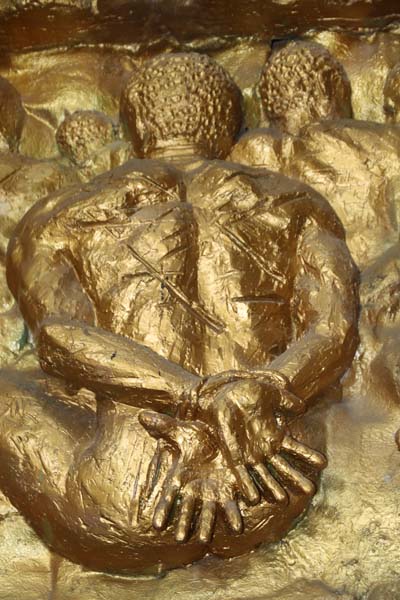
Across from the mausoleum was a musuem and a large hall that was built for one purpose, used once and then never again for the same assembly. The 2008 constitution was formulated and signed here. The party under the new leadership of Rafael Correa convened in the assembly hall in Montecristi and were given six months to draft and present the Constitution for approval. In 2008 they completed the task and the Constitution became law.
The Constitution is the first in the world to recognize legally enforceable Rights of Nature, or ecosystem rights. Article 71-74 prohibits the extraction of non-renewable resources in protected areas. Moreover, the production of monocultures will be avoided for reforestation and rehabilitation of the soil. The state will also protect the intellectual property of collective work based on national biodiversity and begin to recognize the Rights of Nature
Other groundbreaking laws gave new rights to women, same sex relationships and one that surprised me in its meaning where the Constitution guarantees sustainable food sources for all it’s citizens.
Once the constitution was signed the assembly left the hall and never returned. Our guide told us the hall is used for the arts occasionally.

Montecristi
Montecristi is:
- A canton with the town of Montecristi as the capital
- Montecristi is the birthplace of Eloy Alfaro Delgado (25 June 1842-28 January 1912), president of Ecuador from 1895 to 1901 and from 1906 to 1911 and the leader of the Ecuadorian Liberal Revolution.
- The town is renowned for the production of Panama hats, the best quality of which is named montecristi superfino after it.
- As of the 2010 census Montecristi had 70.292 inhabitants
At the center of the town is a square in front of the church called Plaza Cívica de Montecristi. A large bronze statue of Eloy Alfaro Delgado takes center stage in the plaza with the stately white church in the background. 200 steps lead up to the church.
Although the church had a long history and was in itself quite beautiful we found it not quite as opulent as some churches we have seen in other cities. One thing we found odd was an alcove where there was a statue of Christ in a reclining position covered in a Ecuadorian blanket. It was obviously a depiction of the tomb after crucifixion but seemed strange to see it displayed that way. And of course like all Christian churches there were numerious slots in the top of the display where visitors had dropped money into it. So there was a plaster version of the crucified Christ covered in a nicely patterned blanket, with the crown of thorns still on and half covered in US dollars. Sheesh !!
The street leading to the plaza was lined on both sides by shops all selling pretty much the same things. Woven goods, hats, dolls and jewelry. As expected the color were vibrant and the shop owners more than anxious to call you in. My main challenge was to buy a Panama Hat. I had read enough that I knew the range of costs and why they ranged from 25 dollars to 10,000 dollars. Much like fabric for sheets that is in thread count so are the hats rated by fibre count per inch. The higher the count the finer the hat and of course the higher the cost. The superfino hats can take up to a year to weave and looking at them you can really tell the quality.
The salesman layed out hats from $25 to $300 for me and checked my size. Don’t know what it means but I am a size 60. Sounds big I know. I chose the $100 dollar hat because it wasn’t the stark white one and it had a nice tight weave. Negotiated a while and finally agreed on $60 and a wooden box to bring it home in. Poor Marianne almost had a stress attack seeing him show me how to roll it up to fit in the small box.
Finished the visit by M buying the gifts we were bringing home.



